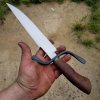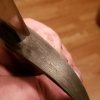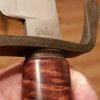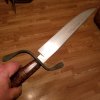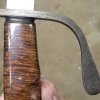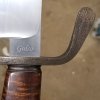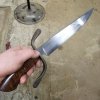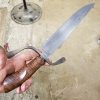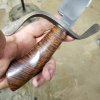My treatments for WI are:
Etch in FC with removal every 60 seconds to scrub off with a veggie brush.
When the etch is deep enough, wash and boil in water with a Tbs of TSP.
Dry well in the oven for an hour at 300F and wire brush clean. It is very important to drive all moisture out of the WI before applying any finish. I don't like chemical bluing solutions becaus sooner of later rust creeps out of the fibrous structure of WI.
To color the part after fully dried:
Heat to 1000+F and then coat with Blacksmith's polish/black ( see below). After cooling to room temp, rub hard with an old cotton T-shirt and hand buff with a clean cloth.
or
Put in 550-600F molten nitrate bluing salts. (low temp salt pot will work, too). Washing well with hot water and then dry in the oven again. Wire brush and wax with beeswax while hot from the oven and buff with a soft cotton cloth after cooled to room temp.
Blacksmith's Polish: For getting that shiny black you love on hand forged blacksmith items ... and knife fittings ... this recipe works well.
Get a quart can of turpentine
Get a pound of beeswax
Put the ingredients in and empty new 1 gallon paint can (Unused paint can - ebay or paint store)
Melt the beeswax slowly and when just melted, REMOVE FROM HEAT and stir in the turpentine.
Warm can to use until melted, stir with a wooden paint stir stick.
Use cheap disposable 1" natural bristle brush ( not synthetic/plastic) to apply polish.
Heat object to about the first hint of red (1000F if using an oven to heat up)
Let cool a bit to black heat (900F), testing with a cotton cloth. You want the piece to cool enough so the cloth doesn't catch fire, but chars and smokes.
Immediately paint the beeswax polish all over the piece heavily. Do this over a foil pan to catch the drip off (Put that back in the storage can for re-use).
Rub the piece briskly with the charred up cotton cloth until it stops all smoking.
Let cool and cloth buff again.
Precautions/Tips -
Heating wax and turpentine wax mix must be done slowly and carefully. It can catch fire. Have a lid or metal plate handy to set over the can if needed.
Wear heavy gloves.
Have a fire extinguisher handy.
Use a large foil roasting pan to catch the debris/drips and to drop the cloth in if necessary when testing (it may catch fire). The pan can be reused over and over.
Setting the wax can or the drip pan out in the sun on a hot summer day will melt it most of the way.
Getting char in the wax mixture in the pan won't hurt anything, so when done with blackening the pieces, wrm the pan and pour the drips into the wax storage can.
